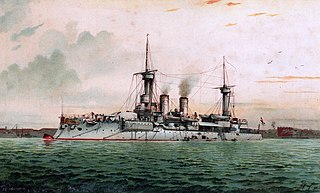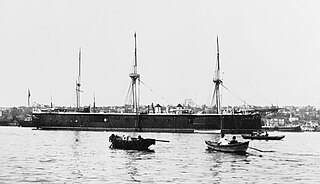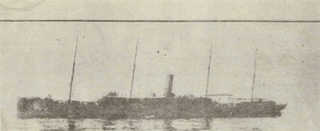
SMS Goeben was the second of two Moltke-class battlecruisers of the Imperial German Navy, launched in 1911 and named after the German Franco-Prussian War veteran General August Karl von Goeben. Along with her sister ship, Goeben was similar to the previous German battlecruiser design, Von der Tann, but larger, with increased armor protection and two more main guns in an additional turret. Goeben and Moltke were significantly larger and better armored than the comparable British Indefatigable class.

The Turkish Naval Forces, or Turkish Navy, is the naval warfare service branch of the Turkish Armed Forces.

SMS Weissenburg was one of the first ocean-going battleships of the Imperial German Navy. She was the third pre-dreadnought of the Brandenburg class, which also included her sister ships Brandenburg, Wörth, and Kurfürst Friedrich Wilhelm. Weissenburg was laid down in 1890 in the AG Vulcan dockyard in Stettin, launched in 1891, and completed in 1894. The Brandenburg-class battleships were unique for their era in that they carried six large-caliber guns in three twin turrets, as opposed to four guns in two turrets, as was the standard in other navies.

Mesudiye was a central-battery ironclad of the Ottoman Navy, one of the largest ships of that type ever built. She was built at the Thames Iron Works in Britain between 1871 and 1875. Mesudiye had one sister ship, though she was purchased by the Royal Navy and commissioned as HMS Superb. Mesudiye's primary armament consisted of twelve 10-inch (250 mm) guns in a central armored battery.

Nusret was a naval ship of the Ottoman Navy, which served as a minelayer during the Gallipoli Campaign, and later fulfilled various roles in the Turkish Navy; as minelayer (1927–1937), diver vessel (1937–1939) and tender (1939–1955). She was laid down in 1911 and launched from Schiff & Maschinenbau AG 'Germania' at Kiel, Germany on 4 December of that year.

HMS E14 was a British E class submarine built by Vickers, Barrow-in-Furness. During the First World War, two of her captains were awarded the Victoria Cross, and many of her officers and men also decorated. HMS E14 was laid down on 14 December 1912 and was commissioned on 18 November 1914. Her hull cost £105,700. She was sunk by shellfire from coastal batteries in the Dardanelles on 28 January 1918.
This list includes fleet organisations of the Ottoman Navy during the Balkan Wars.

Berk-i Satvet was a torpedo cruiser of the Ottoman Navy, the second and final member of the Peyk-i Şevket class. She was built by the Germaniawerft shipyard in Germany in 1906–1907, and was delivered to the Ottoman Navy in November 1907. The ship's primary armament consisted of three 450 mm (17.7 in) torpedo tubes and a pair of 105 mm (4.1 in) guns, and she was capable of a top speed of 21 knots. The ship's early career was uneventful; the Italo-Turkish War of 1911–1912 passed without any action of the Ottoman fleet. Berk-i Satvet saw action during the Balkan Wars of 1912–1913 in the Aegean and Black Seas, against Greek and Bulgarian opponents, respectively.

Peyk-i Şevket was a torpedo cruiser of the Ottoman Navy, built in 1906–1907, the lead ship of her class, which included one other vessel. She was built by the Germaniawerft shipyard in Germany, and was delivered to the Ottoman Navy in November 1907. The ship's primary armament consisted of three 450 mm (17.7 in) torpedo tubes and a pair of 105 mm (4.1 in) guns, and she was capable of a top speed of 21 knots. A major reconstruction in the late 1930s revised her armament and rebuilt her bow and superstructure.

Gonca is a Turkish steamship built sometime between 1907 and 1909 and homeported in Istanbul. The ship currently serves as an excursion ship and steam yacht for charter. It is unknown where the ship was built, but markings on the ship's engine suggest that at least that part of the ship and potentially other machinery was built in Britain. Gonca was constructed as the support ship Selânik for the French harbor management company in charge of developing modern infrastructure for the port of Salonica on behalf of the Ottoman authorities. In the final years of Ottoman rule, the Société Anonyme Ottomane de Construction et Exploitation du Port de Salonique was tasked with developing several modern commercial shipping piers as well as railroad connections and others support infrastructure for the port of Salonica.

Yadigar-i Millet, originally built as SMS S166, was one of the four S138-class torpedo boats built for the German Imperial Navy, but was purchased by the Ottoman Navy National Support Association for the Ottoman Navy.
Nümune-i Hamiyet, originally built as SMS S167, was one of the four S138-class torpedo boats built for the German Imperial Navy, but was purchased for the Ottoman Navy during construction.
Gayret-i Vataniye originally built as SMS S168, was one of the four S138-class torpedo boats built for the German Imperial Navy, but was purchased for the Ottoman Navy during construction.
Yarhisar was one of the four Samsun-class destroyers, based on the Durandal class, purchased from France in 1907 by the Ottoman Navy Society. She joined the Ottoman Navy in 1907, but like the rest of the Ottoman fleet, she did not take part in any active engagement with the Italians during the Italo-Turkish war. During the Balkan Wars of 1912–1913, she took part in all major engagements such as the battles of Kaliakra, Elli and Lemnos, as well as patrol missions. During World War I, she took part in escort and interception missions, especially in the Sea of Marmara. She engaged in many battles with Allied submarines entering the Sea of Marmara. On 3 December 1915, she was torpedoed and sunk by the British submarine HMS E11 off the coast of Yalova. 7 officers and 33 enlisted men were killed in the sinking. The submarine picked up the remaining crew from the sea and delivered them to a nearby sailing ship.

Draç was a torpedo boat of the Ottoman Navy that entered service in 1907. She took part in the Balkan Wars and World War I.
Samsun was one of the four Durandal-class destroyers purchased by the Ottoman Empire from France in 1907. The ship served in the Ottoman Navy during the Italo-Turkish War, the Balkan Wars and World War I.

Tirimüjgan, formerly Pembroke Castle, was a cargo ship launched in 1883 and purchased by the Ottoman Empire from the United Kingdom in 1906, requisitioned as a destroyer tender and used in the Italo-Turkish War, Balkan Wars and served during World War I.
Basra was one of the four Durandal-class destroyers purchased by the Ottoman Empire from France in 1907. The ship served in the Ottoman Navy during the Italo-Turkish War, the Balkan Wars and World War I.
Taşoz was one of the four Durandal-class destroyers purchased by the Ottoman Empire from France in 1907. The ship served in the Ottoman Navy during the Italo-Turkish War, the Balkan Wars and World War I.

Akhisar was a torpedo boat built in Italy during the early 20th century, the lead ship of her class. The ship was launched on 25 April 1904 at the Ansaldo shipyard in Genoa, and became part of the Ottoman Navy in June 1904. The torpedo boat took part in the First Balkan War and World War I, and after an overhaul in the 1920s served under the flag of the Republic of Turkey until 1930. The ship was scrapped in 1935.













